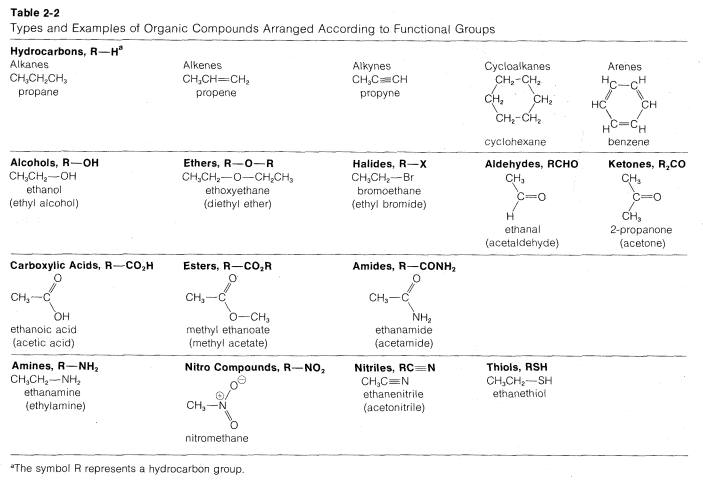


 علم الكيمياء
علم الكيمياء 
 الكيمياء التحليلية
الكيمياء التحليلية 
 الكيمياء الحياتية
الكيمياء الحياتية 
 الكيمياء العضوية
الكيمياء العضوية 
 الكيمياء الفيزيائية
الكيمياء الفيزيائية
 الكيمياء اللاعضوية
الكيمياء اللاعضوية 
 مواضيع اخرى في الكيمياء
مواضيع اخرى في الكيمياء
 الكيمياء الصناعية
الكيمياء الصناعية |
أقرأ أيضاً
التاريخ: 18-9-2018
التاريخ: 2024-04-27
التاريخ: 4-4-2017
التاريخ: 2023-08-24
|
There are a number of recurring types of structural features in organic compounds that commonly are known as functional groups. In fact, a traditional approach to the subject of organic chemistry involves the classification of compounds according to their functional groups. Thus the structural features C=CC, C≡CC, C=O, OH, NH2, and C≡N are the functional groups of alkenes, alkynes, carbonyl compounds, alcohols, amines, and nitriles, respectively. It will be helpful to look at the structural features of some of the major types of organic compounds even though the details of their chemistry will not be discussed until later chapters. Examples of the structures arranged in accord with their functional groups are given in Table 2-2. The examples chosen are representative of compounds containing carbon and hydrogen (hydrocarbons) as well as compounds containing halogens, oxygen, nitrogen, and sulfur. We do not expect you to memorize this table. In time you will become familiar with all of the types of structures in it.
In Table 2-2 we generally have used systematic names as first-choice names because these names emphasize the relationships between the compounds and ease the burden fo the beginning student in having to remember many special names. We have little hope that systematic names such as methanal, 2-propanone, and ethanoic acid soon will replace the commonly used nonsystematic names formaldehyde, acetone, and acetic acid. But there is no question that every organic chemist knows what compounds the names methanal, 2-propanone, and ethanoic acid represent, so the beginner can communicate with these names and later become familiar with and use the special names.




|
|
|
|
التوتر والسرطان.. علماء يحذرون من "صلة خطيرة"
|
|
|
|
|
|
|
مرآة السيارة: مدى دقة عكسها للصورة الصحيحة
|
|
|
|
|
|
|
نحو شراكة وطنية متكاملة.. الأمين العام للعتبة الحسينية يبحث مع وكيل وزارة الخارجية آفاق التعاون المؤسسي
|
|
|